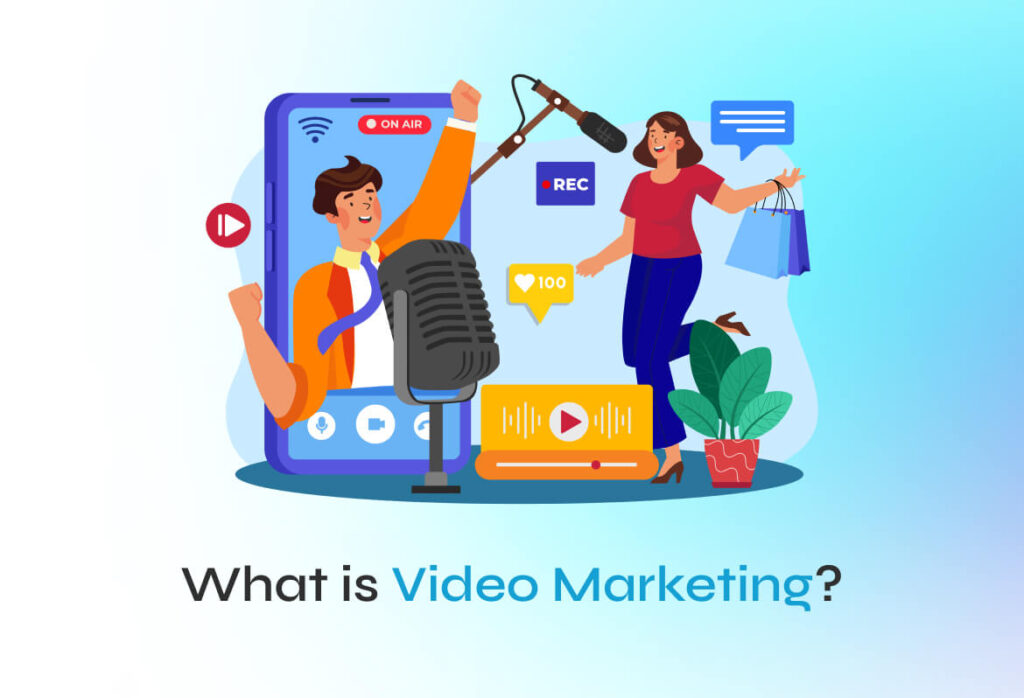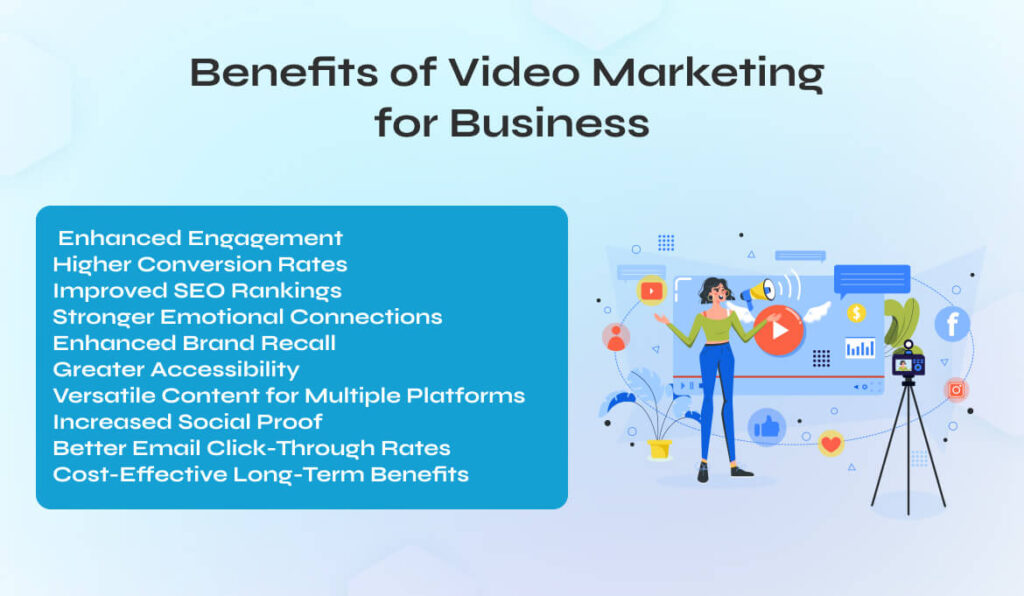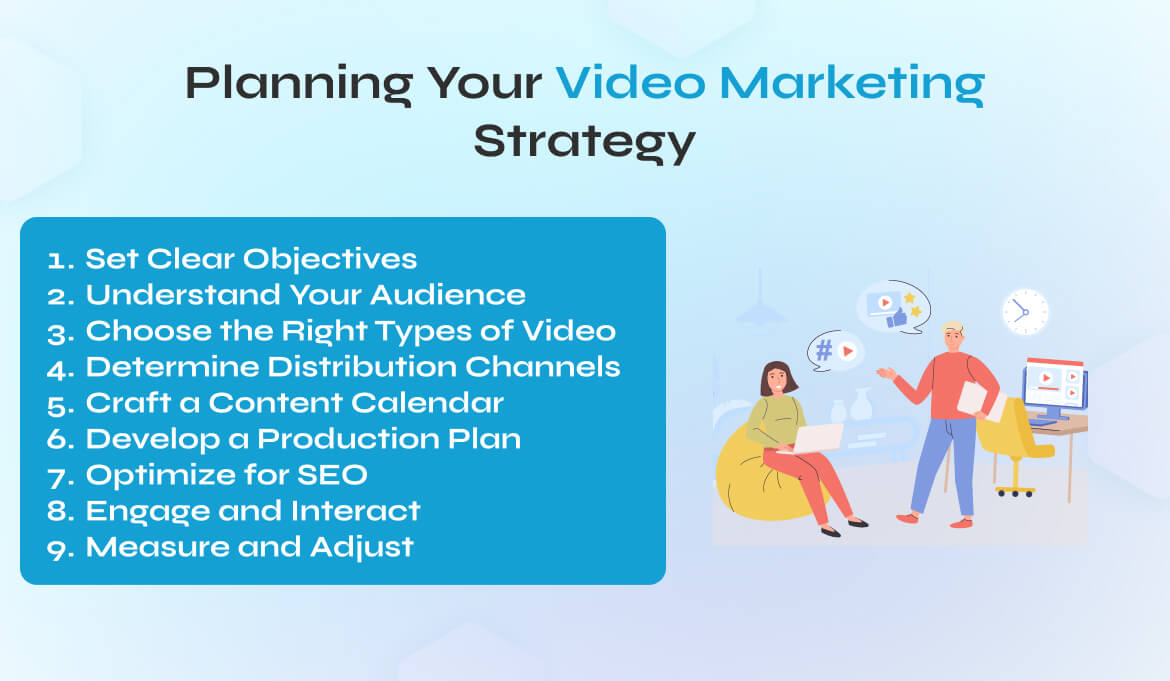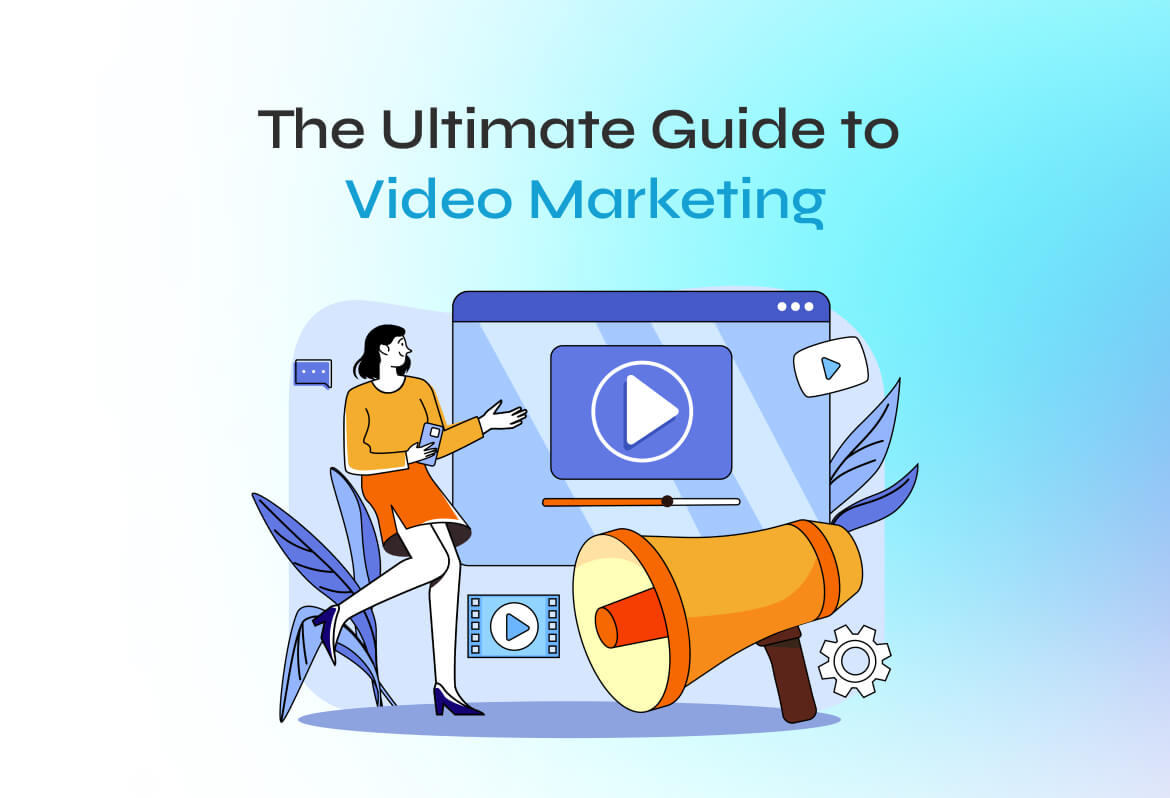Video marketing has great value when it comes to enhanced engagement and connection. With over 4.3 billion people plugged into the web and a significant portion of them influenced by video content, the medium has transitioned from an optional luxury to a cornerstone of modern marketing strategies. This guide is designed to navigate the dynamic world of video marketing, offering insights and strategies to harness its power for your business. Whether you’re a seasoned marketer or a newcomer, understanding the essence of video marketing and how to leverage it can transform your approach to reaching and engaging your target audience.
What is Video Marketing?

Video marketing is the strategic use of video content to promote and market your products or services, increase engagement on your digital and social channels, educate your consumers and customers, and reach your audience with a new medium. From the early days of television commercials to today’s Instagram stories and TikTok challenges, video marketing has evolved into a dynamic and multifaceted tool that caters to a wide array of platforms and preferences. According to the statistics, almost 90% of marketers say video has helped them generate leads. Its significance lies not just in the content but in the way it’s crafted and disseminated to create meaningful interactions with potential and existing customers. In an era where attention is the new currency, video marketing helps businesses cut through the noise and capture the ever-elusive interest of their audience.
Benefits of Video Marketing for Business

Incorporating video into your marketing strategy is not just keeping up with trends; it’s tapping into a powerful medium that can significantly enhance your business’s reach, engagement, and conversion rates. The advantages of video marketing extend across various aspects of business growth:
- Enhanced Engagement: Videos are designed to capture attention. In a world where consumers are bombarded with content, the dynamic and immersive nature of video helps your brand stand out. Videos encourage more social shares than text and images combined, expanding your content’s reach organically.
- Higher Conversion Rates: Integrating video on landing pages and product pages can dramatically increase conversions. Videos can convey your value proposition and product features more effectively than text, helping potential customers visualize the benefits and facilitating quicker purchase decisions.
- Improved SEO Rankings: Videos increase the time spent by visitors on your site. This longer exposure signals search engines that your site contains good content, which can improve your site’s search engine ranking. Moreover, Google’s algorithms prioritize pages with video content in search results, offering an additional boost to your SEO efforts.
- Stronger Emotional Connections: Video has the unique capability to evoke emotions, whether through storytelling, customer testimonials, or showcasing the human side of your brand. This emotional engagement is crucial in building trust and loyalty with your audience, making them more likely to choose your brand over competitors.
- Enhanced Brand Recall: The visual and auditory nature of video ensures higher retention rates and brand recall. Viewers are more likely to remember your message when presented in video format compared to reading it in text, increasing the likelihood of conversion later on.
- Greater Accessibility: Video content is accessible to a wide audience, including those who prefer visual or auditory learning styles over reading. With the rise of mobile internet usage, videos offer a convenient way for people to consume content on the go, increasing the accessibility of your message.
- Versatile Content for Multiple Platforms: Video content can be repurposed across multiple platforms – from your website to social media, email marketing campaigns, and even presentations. This versatility ensures that your investment in video content yields returns across different touchpoints in the customer journey.
- Increased Social Proof: Customer testimonials and case studies presented in video format serve as powerful social proof, validating your product or service through real-life success stories. This not only enhances credibility but also helps potential customers see the tangible impact of your offering, further influencing their buying decision.
- Better Email Click-Through Rates: Including the word “video” in your email subject line can increase open rates and significantly boost click-through rates. Embedding videos in your emails or linking to video content can make your email marketing efforts more engaging and effective.
- Cost-Effective Long-Term Benefits: While producing high-quality videos may require an initial investment, the evergreen nature of video content ensures long-term benefits. Videos can be viewed and shared repeatedly, providing continuous engagement and lead-generation opportunities without additional cost.
By embracing video marketing, businesses can leverage these myriad benefits to create deeper connections with their audience, differentiate themselves in a crowded market, and drive tangible business results.
Planning Your Video Marketing Strategy

Developing a compelling video marketing strategy is crucial for ensuring your video content effectively reaches your target audience and meets your business objectives. A well-thought-out strategy provides a roadmap for creating impactful videos that resonate with viewers and drive desired actions. Here are essential steps to take when planning your video marketing strategy:
- Set Clear Objectives: You can begin by identifying what you aim to achieve with your video marketing efforts. Objectives can range from increasing brand awareness, generating leads, and boosting website traffic, to enhancing customer engagement. Ensure your goals are specific, measurable, attainable, relevant, and time-bound (SMART) to facilitate clear tracking and evaluation of your campaign’s success.
- Understand Your Audience: A deep understanding of your target audience is critical. Who are they? What are their interests, pain points, and preferences? Conduct market research, utilize social media analytics, and gather customer feedback to create detailed buyer personas. This knowledge will guide the tone, content, and distribution channels for your videos, making them more relevant and engaging to your audience.
- Choose the Right Types of Video: The format of your video should align with both your objectives and audience preferences. Whether it’s explainer videos, product demonstrations, customer testimonials, or behind-the-scenes glimpses, each type serves a different purpose and resonates differently with viewers. Consider diversifying your video content to keep your audience engaged and interested.
- Determine Distribution Channels: Your choice of platforms for sharing your videos is as crucial as the content itself. Different channels offer unique advantages, whether it’s your website for increasing traffic, social media platforms like YouTube, Instagram, or TikTok for broader reach, or email campaigns for personalized engagement. Choose platforms that align with where your target audience spends their time online.
- Craft a Content Calendar: Planning when and where each video will be published helps ensure a consistent and organized approach to your video marketing. A content calendar aids in visualizing your strategy over time, allowing for adjustments and strategic alignment with key business events, holidays, or product launches.
- Develop a Production Plan: Video production requires careful planning, from scripting and storyboarding to filming and editing. Outline the resources needed, including equipment, personnel, and budget. Consider whether to produce in-house or partner with external production companies. A detailed production plan helps streamline the creation process and ensures high-quality outcomes.
- Optimize for SEO: Videos also need to be optimized for search engines to enhance visibility. Include relevant keywords in your video titles, descriptions, and tags. Utilize closed captions and transcripts to make your content more accessible and SEO-friendly.
- Engage and Interact: Plan for engagement by encouraging viewers to like, share, comment, or subscribe. Include calls-to-action (CTAs) in your videos to guide viewers on what to do next, whether it’s visiting your website, signing up for a newsletter, or watching another video.
- Measure and Adjust: Identify key performance indicators (KPIs) relevant to your goals, such as view count, engagement rate, conversion rate, and social shares. Regularly analyze these metrics to understand what’s working and what isn’t, and be prepared to adjust your strategy accordingly for continuous improvement.
A meticulously planned video marketing strategy not only sets the direction for your content creation efforts but also ensures every video you produce contributes to your broader marketing goals. By following these steps, you can create a cohesive and effective video marketing campaign that resonates with your audience and drives measurable results.
Creating Engaging Video Content
The core of video marketing lies in creating content that engages and compels your audience to take action. Key tips include:
- Focus on Storytelling: Narratives that evoke emotion or provide value tend to resonate more.
- Keep It Concise: Attention spans are short; make your point quickly and effectively.
- Prioritize Quality: High production values can significantly affect your video’s perceived value and your brand’s image.
Video Content Marketing Strategy
Integrating video into your overall content marketing strategy amplifies its effectiveness. Consider SEO by using relevant keywords in your video titles and descriptions, and ensure your content addresses the questions and needs of your audience. Utilizing video analytics, you can refine your strategy to better meet the preferences of your viewers.
FAQ's
What is video marketing?
Video marketing is the strategic incorporation of video content into marketing efforts to promote brands, products, or services, enhance digital and social engagement, educate consumers, and connect with audiences through a visually engaging medium.
Why is video marketing important for businesses today?
With the vast majority of consumers preferring video content over text and images, video marketing has become crucial for capturing attention, improving engagement, driving sales, and enhancing brand recall in a crowded digital landscape.
How can video marketing impact my business?
Video marketing can significantly increase your brand’s visibility, improve customer engagement, boost conversion rates, enhance SEO rankings, and build a stronger emotional connection with your audience, leading to increased brand loyalty.
What types of video content are most effective?
The effectiveness of video content varies by objective and audience, but popular formats include explainer videos, product demos, customer testimonials, how-to guides, and behind-the-scenes tours.
How do I start with video marketing if I have a limited budget?
Start small by creating simple videos using smartphones or affordable cameras. Focus on content quality and storytelling. Use free or low-cost editing software, and consider leveraging user-generated content or collaborating with influencers to reduce production costs.
Can video marketing improve my website’s SEO?
Yes, videos can significantly improve your SEO by increasing the amount of time visitors spend on your site, signaling to search engines that your site has quality content. Ensure your videos are optimized with the right keywords, titles, and descriptions.
How do I measure the success of my video marketing efforts?
Measure success by tracking metrics such as view count, engagement rates (likes, shares, comments), conversion rates, and click-through rates. Tools like Google Analytics and social media analytics can provide these insights.
How often should I publish new video content?
The frequency depends on your capacity to produce quality content and your audience’s appetite for video. However, maintaining a consistent posting schedule is key to keeping your audience engaged and growing your viewer base.
Should my video marketing strategy be different for each social media platform?
Yes, each platform has its unique audience and content preferences. Tailor your videos to fit the platform’s format and user behavior. For example, shorter videos work better on Instagram and TikTok, while longer-form content may be more suitable for YouTube.
How can I make my videos stand out in a saturated market?
Focus on storytelling, ensure high-quality production, be authentic, and directly address your audience’s needs and interests. Unique, engaging content that adds value will always stand out, regardless of market saturation.
Conclusion
As we wrap up this guide to video marketing, it’s evident that video isn’t just an optional marketing tool; it’s essential for engaging and connecting with today’s audiences. The journey through planning, creating, and integrating video content into your marketing strategy underscores its power to transform how we communicate with our target audience. Video marketing offers a unique blend of storytelling, engagement, and versatility that other mediums can’t match, making it an indispensable asset in your digital marketing arsenal.
Embracing video marketing means more than just keeping up with trends, it’s about actively engaging your audience in a dynamic and impactful way. By focusing on strategic planning, creative content, and continuous optimization, businesses can leverage video to not only reach their audience but also resonate with them on a deeper level. Remember, the success of your video marketing efforts lies in your ability to innovate, adapt, and always keep your audience at the heart of your strategy.





